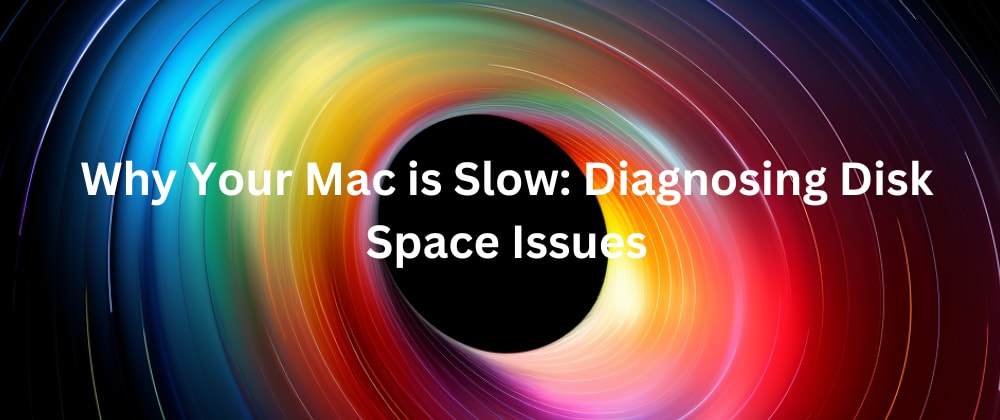The spinning rainbow wheel. Every Mac user's dreaded nemesis. As developers, we often push our machines to the limit, running multiple IDEs, spinning up local servers, and juggling between browsers with dozens of tabs. But when our trusty Mac starts to lag, it's not just an inconvenience—it's a productivity killer. And while there could be a myriad of reasons for the slowdown, one of the most overlooked culprits is disk space (or the lack thereof).
But why does a lack of disk space cause such a significant slowdown? And more importantly, how can we diagnose what's eating up our precious gigabytes?
Understanding Disk Space and Performance
Disk space isn't just a place to store your files; it's a crucial component of your Mac's performance. When you're running low on space, your system has to work harder, often leading to noticeable slowdowns. But before we dive into the nitty-gritty, let's get a foundational understanding of how disk space impacts performance.
SSDs vs. HDDs: Modern Macs come equipped with Solid State Drives (SSDs), which are faster and more reliable than the older Hard Disk Drives (HDDs). However, SSDs have a catch: as they fill up, their performance can degrade. While HDDs suffer from fragmentation issues when they're near capacity, SSDs struggle with longer write times. So, if you're pushing your SSD to its limits, you're likely compromising its speed.
Swap Space and Virtual Memory: macOS, like other operating systems, uses a concept called "swap space." When your RAM is full, macOS will start "swapping" data between the RAM and the disk. This virtual memory allows your Mac to handle more tasks than the RAM could alone. But here's the kicker: if your disk is nearly full, this swapping process becomes sluggish, leading to those dreaded slowdowns.
Common Disk Space Culprits for Developers
As developers, we have a unique relationship with our machines. We demand performance, but we also consume a lot of space with our tools and projects. Let's explore some of the most common space-hogging culprits:
Development Environments: Virtual machines, Docker containers, and local databases can take up a significant chunk of space. For instance, a single Docker image might be lightweight, but if you have multiple containers and images, it adds up quickly.
Version Control: Git is fantastic, but it can also be a space hog. Cloned repositories, especially those with extensive histories or large files, can consume more space than you might expect.
Build Artifacts: After compiling your code, you're left with binaries, logs, and temporary files. While they might seem insignificant individually, they accumulate over time, especially if you're working on multiple projects.
Caches: IDEs, browsers, and other tools use caches to speed up operations. But these caches, if not managed, can grow and consume a surprising amount of disk space.
Large Datasets: Whether you're working with machine learning models or testing large-scale applications, datasets can be massive. And while they're essential for your work, they're also prime candidates for space consumption.
macOS-Specific Tools and Methods to Diagnose Space Consumption
Knowledge is power. Before we can reclaim our disk space, we need to know what's occupying it. Thankfully, macOS offers a plethora of tools, both built-in and third-party, to help us diagnose our storage woes.
Built-in Tools:
About This Mac: Navigate to the Apple menu > About This Mac > Storage. Here, you'll get a bird's-eye view of your storage distribution. It categorizes space usage into apps, photos, audio, movies, and backups, giving you a quick idea of where to start cleaning.
Disk Utility: Found in the Utilities folder, Disk Utility isn't just for repairing disks. The 'Info' button provides details about the selected drive, including capacity, used space, and free space.
Third-Party Tools:
DaisyDisk: With its intuitive and visually appealing interface, DaisyDisk provides a graphical representation of your storage, allowing you to quickly identify and delete large files and folders.
OmniDiskSweeper: This tool offers a more detailed, list-based view of files and directories sorted by size. It's perfect for those who prefer granularity over graphical representations.
GrandPerspective: Another visual tool, GrandPerspective uses treemaps to display the file system's content, making it easier to spot large files or directories at a glance.
OnyX: OnyX is a multifunctional tool for maintaining and optimizing your Mac. It offers a deep dive into the macOS file system, allowing users to verify startup disks, rebuild databases, and clear out a variety of caches. For developers, its detailed logs and automation scripts can be a lifesaver. The tool provides a granular level of control, making it perfect for those who know their way around macOS and want a powerful tool to keep their system in top shape.
Terminal Commands:
For those who love the command line, macOS offers powerful utilities to dissect storage usage:
du: Short for "disk usage", this command provides a summary of directory space usage. For instance,du -sh *will show the size of each file and directory in the current directory.df: This "disk free" command displays the amount of disk space used and available on your Mac's file systems.ncdu: An NCurses-based disk usage viewer,ncduoffers a more interactive and user-friendly way to explore disk usage from the terminal.
Tips for Regular Maintenance
Now that we've equipped ourselves with the tools to diagnose, let's talk about prevention. Regular maintenance can keep disk space issues at bay, ensuring your Mac runs smoothly.
Scheduled Cleanups: Set calendar reminders or use automation tools like Automator or Hazel to perform routine cleanups.
External Storage: Consider offloading large datasets or infrequently accessed files to external drives or cloud storage solutions.
Regularly Update and Prune Development Tools: Outdated SDKs, libraries, or tools can accumulate over time. Periodically review and remove what's no longer needed.
Mind Your Clones: When working with Git, consider using shallow clones or sparse checkouts for large repositories. This ensures you only pull the data you need.
Actionable Steps to Reclaim Disk Space and Boost Performance
Now that we're armed with knowledge and tools, it's time to roll up our sleeves and get to work. Here's a step-by-step guide to decluttering your Mac and ensuring it runs at its optimal best.
1. Start with the Low-Hanging Fruit:
Empty the Trash: It sounds basic, but you'd be surprised how much space is occupied by files you've already decided to delete.
Clear Browser Caches: Web browsers store a lot of data. Periodically clearing their caches can free up a significant amount of space.
Delete Old Downloads: The Downloads folder is often a graveyard of old files. Sort by size and date, and purge what you don't need.
2. Dive Deeper with Diagnostic Tools:
Use tools like DaisyDisk or OmniDiskSweeper to identify large files or folders. Be cautious and ensure you're not deleting essential files.
For developers, pay special attention to old project folders, outdated virtual machines, or stale Docker images.
3. Manage Your Development Environment:
Optimize Docker: Regularly prune unused Docker objects using commands like
docker system prune.Clean Up IDEs: Integrated Development Environments can accumulate cache and log files. Tools like JetBrains' IDEs have built-in cache invalidation options.
Archive Old Projects: Instead of deleting, consider archiving old projects to external storage or cloud solutions.
4. Automate Regular Cleanups:
Use macOS's Automator to create custom workflows for routine cleanups.
Consider third-party apps like Hazel that can monitor folders and perform actions based on custom rules.
5. Consider Upgrades:
If you're consistently running out of space, it might be time to consider hardware solutions:
Upgrade Your Internal Storage: If your Mac model allows, consider upgrading to a larger SSD.
External SSDs: Modern external SSDs are fast and can be a seamless extension of your internal storage.
Conclusion
A cluttered disk isn't just about lost space; it's about lost productivity. By regularly diagnosing and addressing disk space issues, you ensure that your Mac remains a reliable partner in your coding endeavors. But our journey into optimizing our Macs doesn't end here. In upcoming articles, we'll delve deeper into specific cases we touched upon today, like managing Docker images, optimizing web projects, mastering CLI commands for disk management, and more. Remember, a clean Mac is a happy Mac, and a happy Mac makes for a happy developer. Stay tuned for more insights and actionable tips to keep your development environment in peak condition!









Top comments (0)